Christmas markets have a long tradition in Germany, in some cases even going back to medieval times. In Munich, advent markets are first mentioned in documents dating back to 1320. Today there are numerous markets all over the city, welcoming locals and visitors alike.
In this blog post, you will learn about what to expect at a Christmas market and where Munich’s best Christmas markets are at.
What is a Christmas Market, Anyway?
Christmas markets are temporary markets that run for about four weeks prior to Christmas in towns and cities across Germany. They are set up in public squares and consist of wooden stall/huts/chalets, whatever you wish to call them, that sell an array of goods as well as food and drinks.
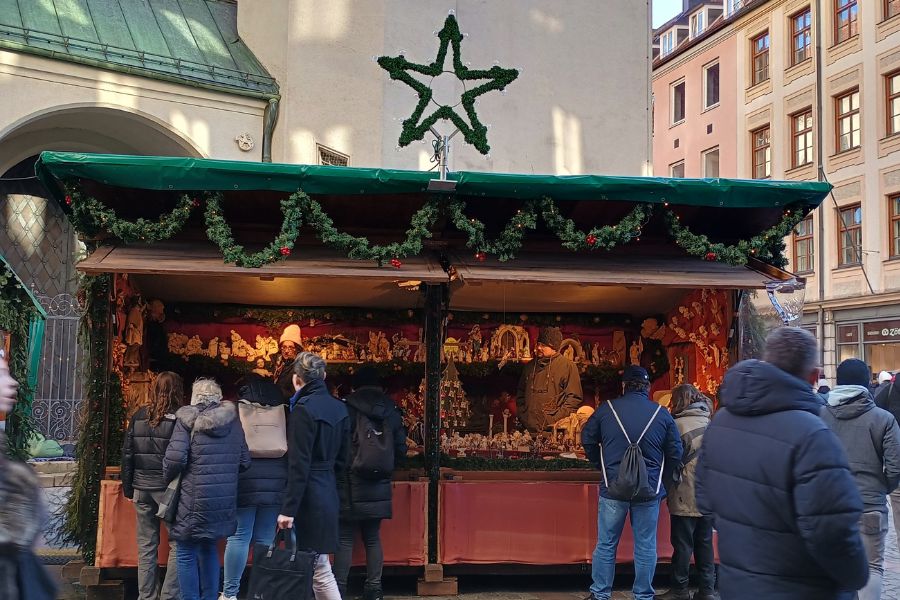
These days, they are practically everywhere, offering an opportunity for Christmas shopping and for socialising. If there is a public square and a permit to set up stalls, there will be a market. In addition, markets can be set up by private operators on private property.
The markets have become a major tourist attraction, with people travelling to Munich and other cities just to experience them.
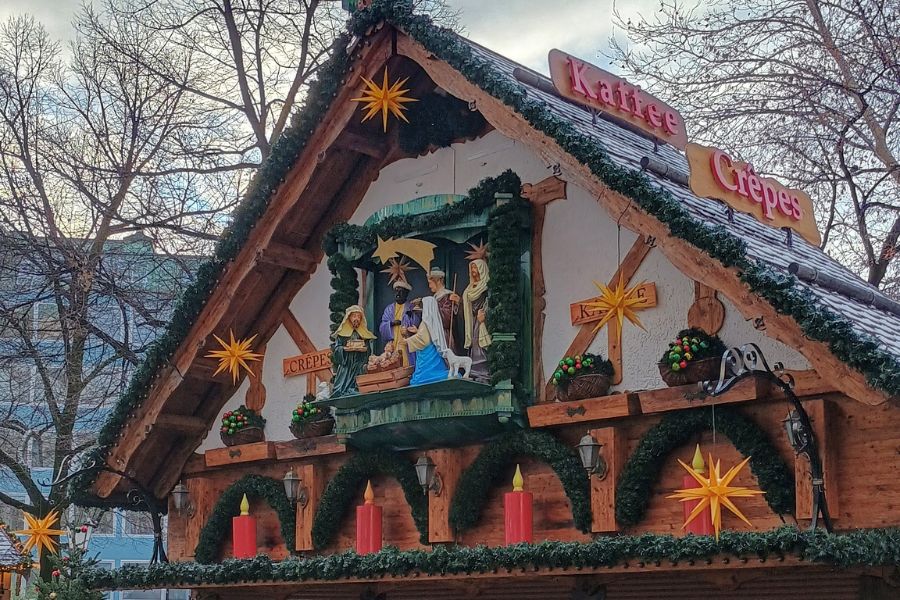
If, for some strange reason, a square is left without a Christmas market, someone will be selling Christmas trees there. Trees are available in various sizes, including some small enough to fit on a dinner table. This is due to the fact that most people in Germany live in apartments and do not have sufficient space for a large tree.
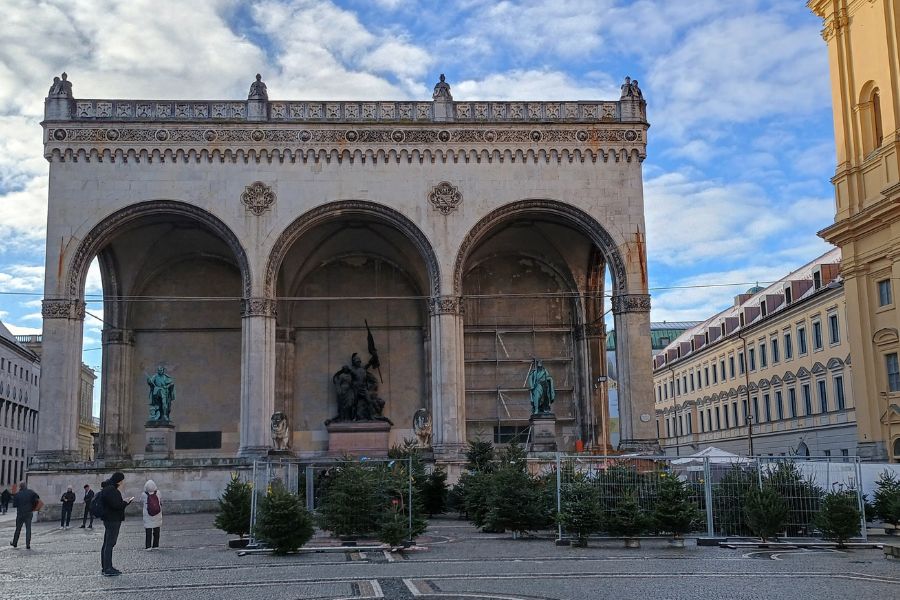
When Do the Christmas Markets Open?
Traditional Christmas markets will typically open about one month before Christmas and close no later than December 24. Some other markets may open earlier and may stay open until the end of the year or even early January.
While they are running, the markets typically open at around 11 a.m. and close at some point in the evening, usually at 9 p.m. or later. They get very busy especially in the evenings, when locals drop by for a Glühwein on their way home from work.
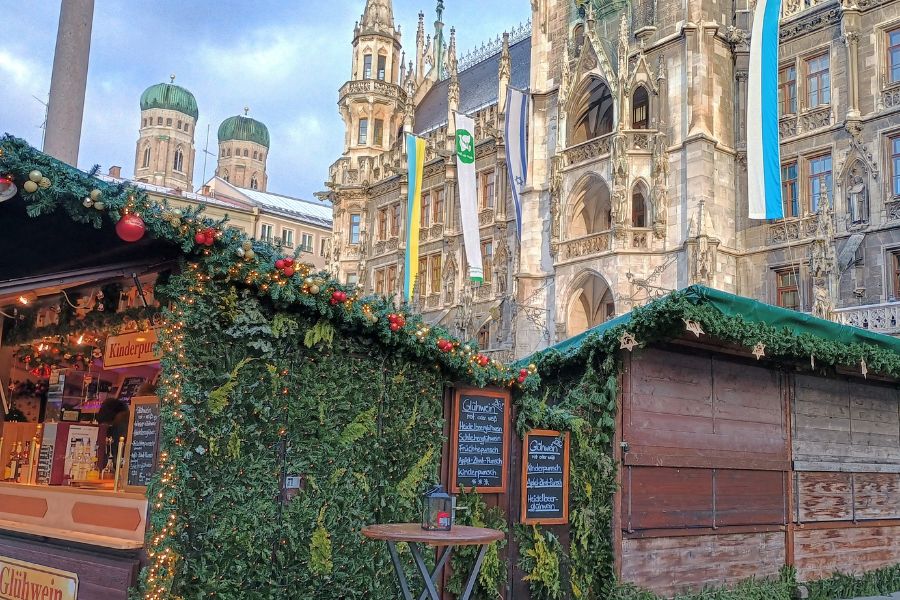
In smaller towns that do not get so many visitors, Christmas markets may only be open for a shorter period of time, and may have different opening hours. For instance, the market in Lörrach, a small German town near Basel in Switzerland, was only open for two weeks. But it was lovely, and much cheaper than across the border!
What to Buy at a Christmas Market?
Christmas markets are your chance to stock up on ornaments for your Christmas tree. Ornaments in Germany are typically a family heirloom and are passed down from generation to generation. Traditionally, they are stars, angels, etc., made of straw, wood, or hard wax.
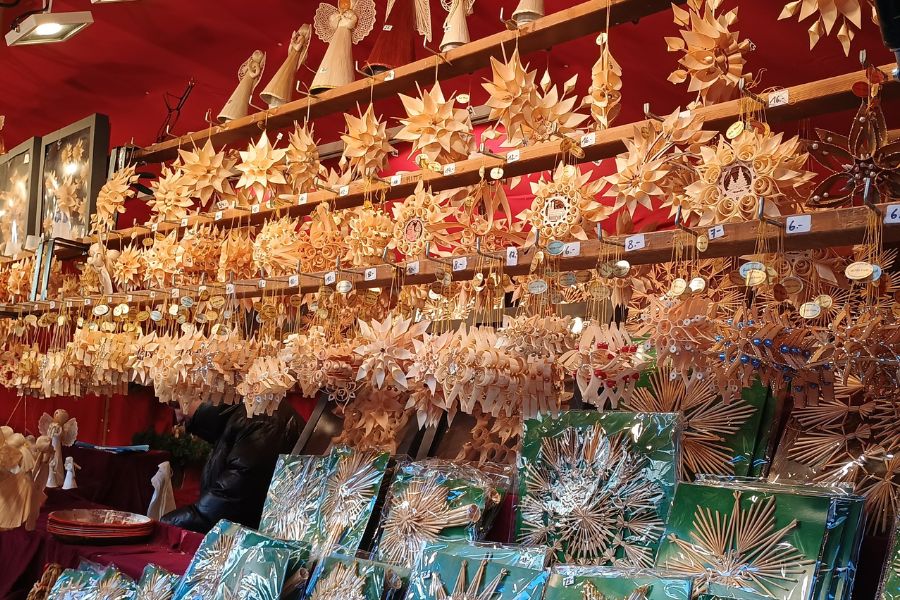
These days, many stalls are selling brightly coloured metal or plastic ornaments. These may look fun, but are most definitely not traditional.
Most Christmas markets will today sell pretty much anything – clothes, jewellery, handicrafts, or just junk.
What to Eat and Drink at a Christmas Market?
The answer is: a lot! 🙂
Drinks
Most (local) people will head to a Christmas market to socialise with friends over a hot drink, or three.
Glühwein is an all-time favourite. Glühwein, or mulled wine or vin chaud, is wine infused with spices (such as cinnamon bark, cloves, cardamom) and then heated. Gently, so the alcohol doesn’t evaporate!
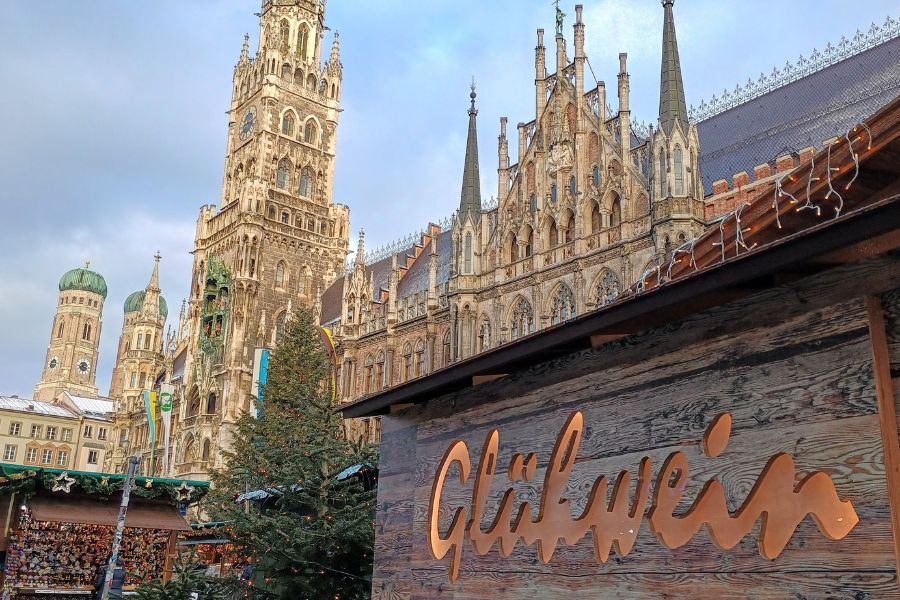
Glühwein is now offered in stunning varieties. Originally it was only made with red wine, but today there is Glühwein made from white wine, from other fruit wines etc.
Punsch is Glühwein that has been mixed with (mostly) juice.
Feuerzangenbowle has also gained in popularity. It is similar to Glühwein in its basic composition. However, it is served in special mugs that have a little lip on which a sugar cube dipped in rum is placed. This sugar cube is set on fire and melts into the drink.
Every market (if not every seller) will also have non-alcoholic hot drinks available. These are usually called „Kinderpunsch“, but depending on the type of market may have a funny name. Look for „alkoholfrei“ or „alk.frei“. They are usually hot juice with or without spices. Hot chocolate is also often available.
In addition to the cost of your drink, you will have to pay „Pfand„. This is a deposit that will be refunded when you return your mug to the stall. Or it’s the purchasing price if you decide to keep your mug as a souvenir. 😉 The Pfand range is very wide – I have seen anything from 1.50 € at a small market to 15 € for a special ceramic Feuerzangenbowle mug.
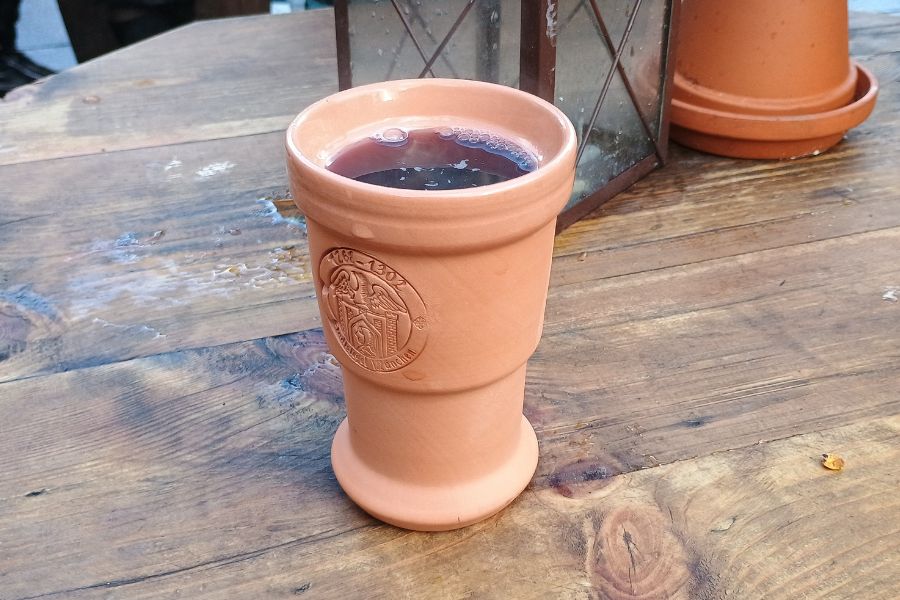
Christmas Markets & Food Tour
Looking for a tour that visits multiple Christmas markets and lets you try a variety of foods? Search no more – drop me a message and let’s chat! (Meanwhile I finalize my landing page for this tour.)
Food
The Christmas market food menu, too, has expanded over the years. For the longest time, the staples have been:
- Crêpes (i.e., thin French-style pancakes) with sugar & cinnamon, with apple sauce, or with Nutella;
- Candied almonds (or hazelnuts, macadamia nuts, sunflower seeds , …);
- Fried sausages for those lacking a sweet tooth.

Other favourites include:
- Flammbrot, dough topped with sour cream, bacon bits and spring onions and baked in the oven (now available with many different toppings, including vegetarian);
- Reiberdatschi, pancakes made from shredded potatoes and topped with apple sauce or salmon or whatever else you can think of.
Basically, anything that can easily be eaten (ideally with your hands to minimize the clean-up effort) will be sold at a Christmas market. I have seen Ethiopian food; Indian butter chicken; and Hamburg fish soup, neither of which is a typical Bavarian dish.
How to Prepare for Your Visit to a Christmas Market
First of all, you can totally visit the Christmas markets on your own. You do not need to join a tour. If you are comfortable travelling individually, off you go!
Logistics
Book your flight and accommodation well in advance. Munich and other city get very busy with Christmas-market tourists these days. If you want to stay in central Munich, you will have to book months in advance and/or expect to pay a lot of money. Having said that, Munich has excellent public transportation. You can therefore easily stay in more residential areas that are just a quick subway ride from the center. Or you may even choose to stay outside of Munich altogether, thus experiencing a very different side of Bavaria.
With so many visitors in town, restaurants get very busy too. You will always be able to grab a Bratwurst or a doner kebab, but for a sit-down meal, make a booking.
Clothing
While Munich doesn’t seem to get very cold anymore, remember you will be spending a lot of time outside. A warm coat, hat, and gloves are therefore highly recommended, as are winter shoes/boots and socks to keep your feet warm. Make sure they are sturdy – the markets are usually so busy that someone will step on your toes sooner or later.
Other than that, there is no dress code at a Christmas market. Germans don’t do Christmas sweaters, either, although they have been spotted here and there in recent years.
Money Matters
Bring cash. Euros only.
Germany is still very much a cash-based society. Do not assume you will be able to pay by card everywhere.
Safety
Generally speaking, Munich is a very safe city. However, you will want to keep an eye on your valuables. Remember that pickpockets like to operate in busy areas.
If you are travelling as a woman on your own or with a friend, take the usual precautions. Don’t tell anybody you are on your own, where you are staying etc. And do not, ever, accept a drink that someone just places in front of you.
Emergency numbers in Germany are 110 (police) and 112 (ambulance/fire brigade).
Where are the Best Christmas Markets in Munich?
Most visitors, especially if they have only limited time in Munich, will only be able to visit the centrally-located markets. I think that is a real shame, as the markets typically get less touristy the farther you move from the center. Therefore, I am including two markets that I think are well worth a visit even though they require a ride on public transit. Additional smaller markets can be found in residential neighbourhoods, e.g., at Harras or Rotkreuzplatz. Venture out there if you are feeling like a less touristy experience!
Christkindlmarkt on Marienplatz
Right smack in front of the town hall and spilling into the surrounding streets is Munich’s biggest Christmas market.
Marienplatz, Munich’s central square, is busy at the best of times and basically impossible to cross in December while the market is on.
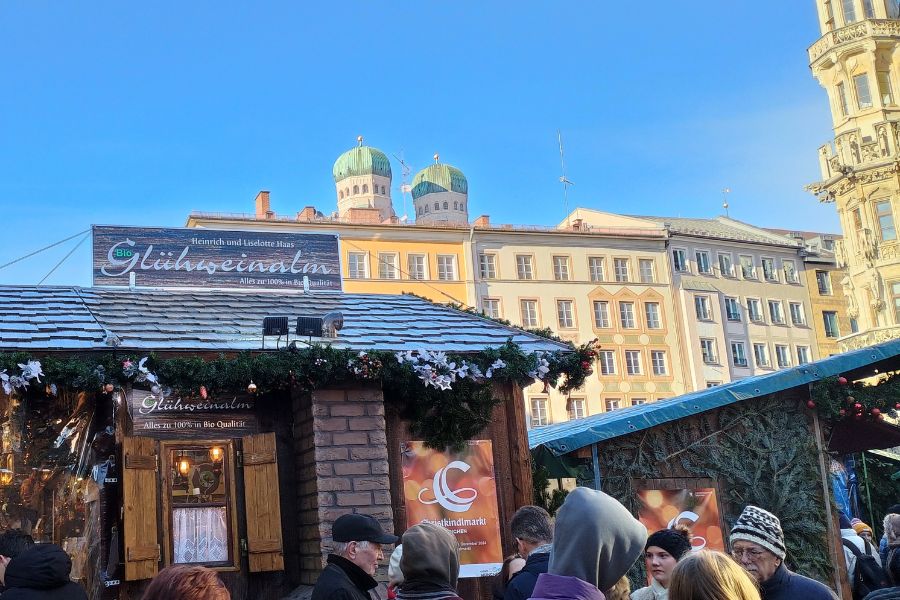
Expect much food and drink, high prices and not-always-locally-made goods on offer. Also watch your personal belongings; it’s very crowded. Munich’s official Christmas tree is also at Marienplatz. Every year, it is given to the city as a gift by a different town or city. The locals like to come out and complain about the tree being too small, ugly, etc.
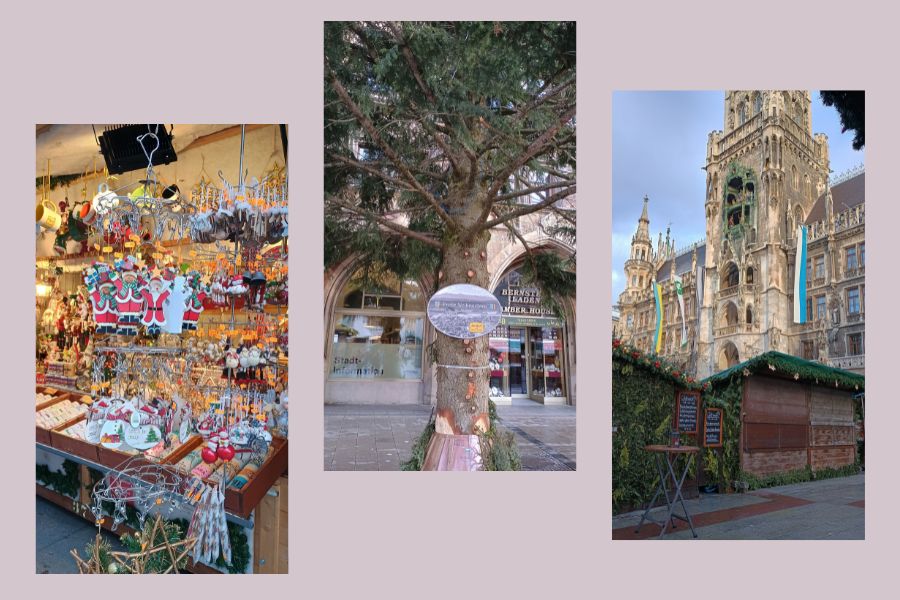
The stalls around St. Peter’s Church specialise in wooden crèches, figurines and accessories. Traditionally, German families would have such a crèche depicting the nativity scene, and would purchase an additional figurine from time to time. These are handmade and therefore quite costly. Crèches were first sold in central Munich in 1757.
How to get there: take subway lines U3 or U6, or any S-Bahn line (except S7 and S20) to Marienplatz. Take any exit you like.
Christmas Market in the Residenz‘ Imperial Courtyard
The former royal palace, the Residenz, stretches south from Odeonsplatz. Its Kaiserhof, or Imperial Courtyard, hosts a small Christmas market. It has a few stalls selling more or less interesting goods, and the usual food and drink. It gets very crowded in the evenings, when the atmosphere is best.
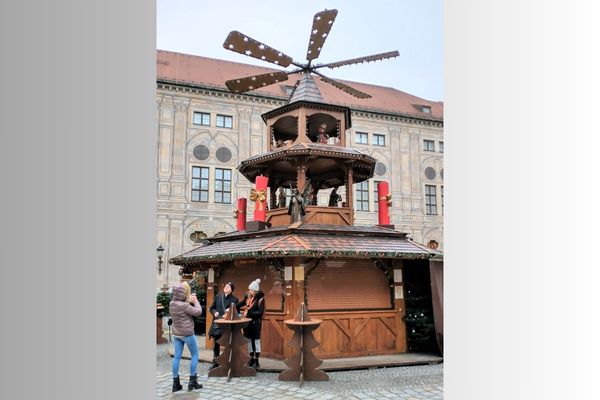
How to get there: take subway lines U3 and U6 to Odeonsplatz, take the exit to Hofgarten, walk straight ahead and then take a left into the first courtyard opening.
Medieval Market on Wittelsbacherplatz
Another nice market with a great atmosphere that gets very crowded in the evening. The stalls are a bit less cookie-cutter-like, and the staff are dressed in medieval(ish) garb. Some of the goods for sale have a medieval connection, but most don’t. They have nicer mugs than other markets, in case you are looking for a souvenir.
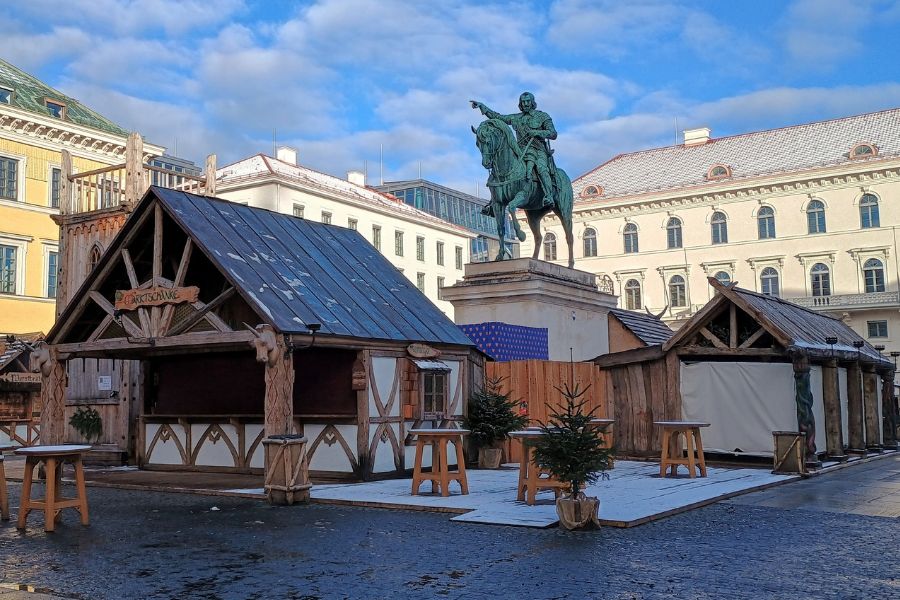
How to get there: take subway lines U3 or U6 to Odeonsplatz. Take the exit Brienner Str. and walk west. Wittelsbacherplatz is just one block away. From Marienplatz, walk up the pedestrian streets until you get to Odeonsplatz, then turn left.
Schwabinger Weihnachtsmarkt at Münchner Freiheit
This market has lots of artisans selling their handmade products. In addition, there are music performances in a small tent. No shortage of food and drink, either. The entire atmosphere is artsy rather than Christmas-y.
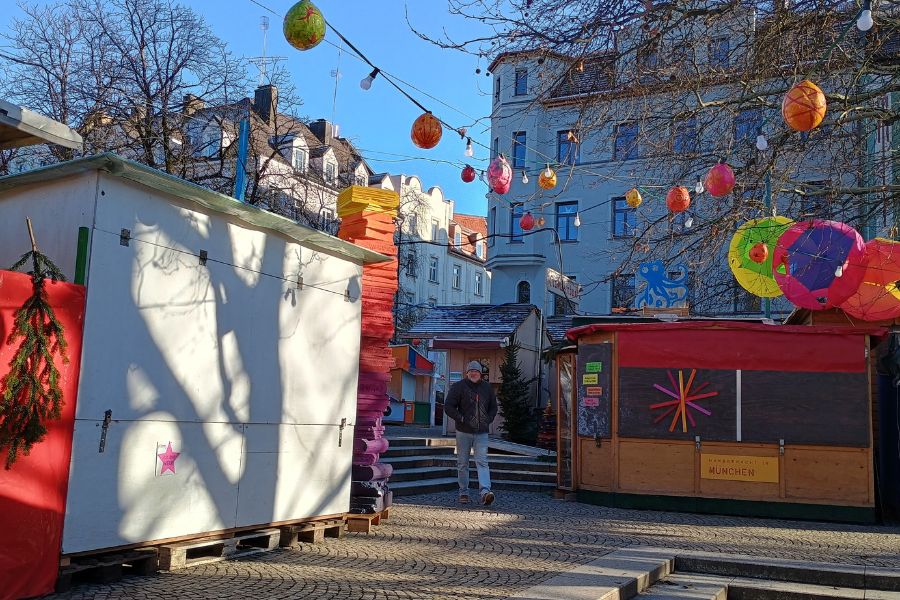
How to get there: take northbound subway lines U3 or U6 to Münchner Freiheit. Go up to the mezzanine level (there is only one way up from the platforms) and then walk straight ahead. The long corridor will take you to the bottom of the market.
If the weather is nice and you feel like walking, walk down Feilitzschstr to the English Gardens and make your way back towards the city center. On Feilitzschstr, you are in the heart of old Schwabing, which was the place to be in the roaring sixties.
Tollwood at Theresienwiese
Once an alternative event, Tollwood has become thoroughly commercialised. It’s a large market with several big tents (nice and warm on cold winter nights) that seems like a fair more than like a Christmas market. Still, it’s fun to explore. Besides the market, it offers a rich cultural programme with concerts and shows. There is a lot of food, so come with an empty stomach!
There is also a Tollwood summer festival in the Olympic park each June/July.
How to get there: Tollwood is on Theresienwiese, where the Oktoberfest takes place as well. Take subway lines U4 or U5 to Theresienwiese, or U3 or U6 to Goetheplatz (plus a walk of 5-10 minutes).
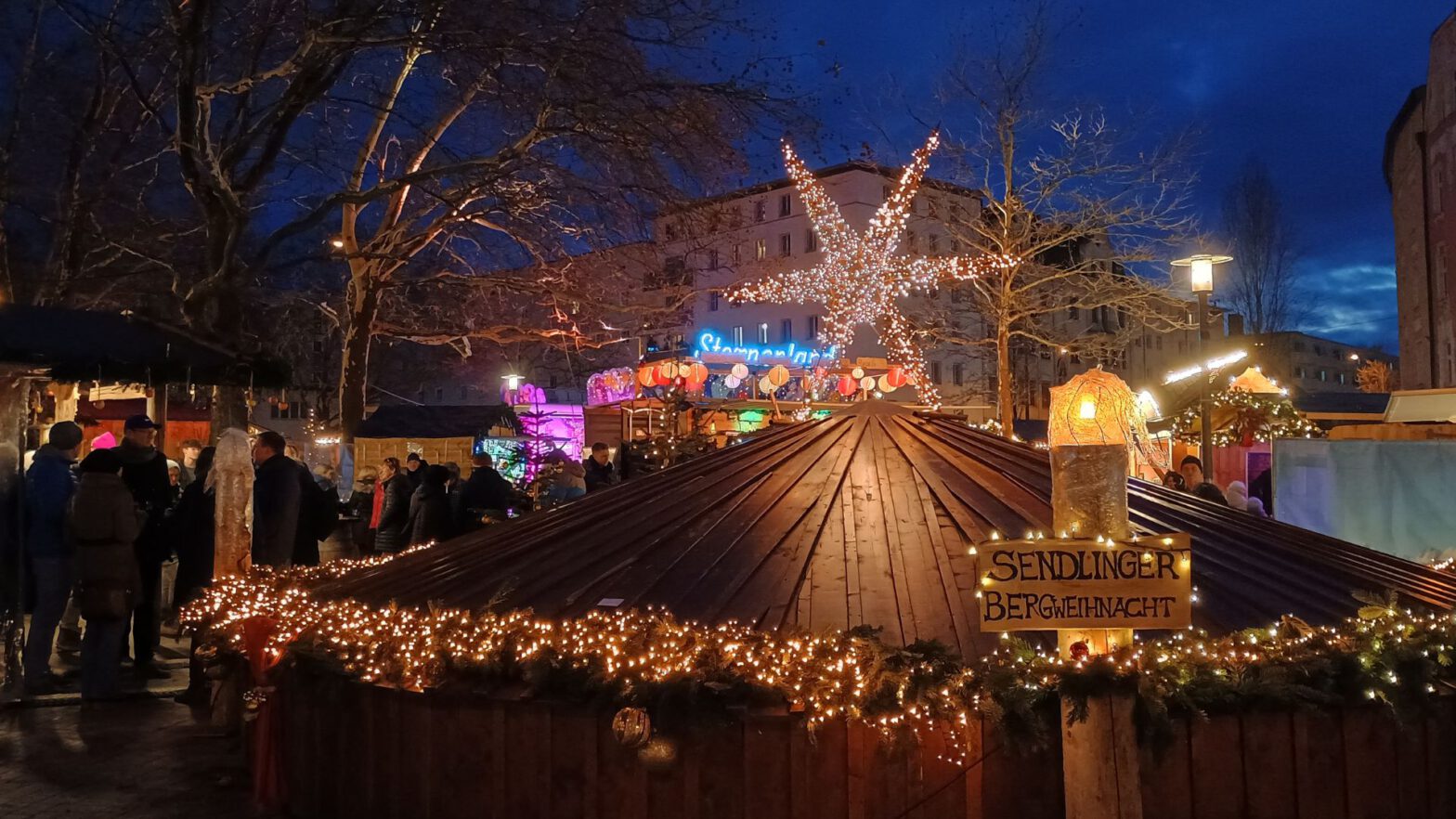
2 Kommentare